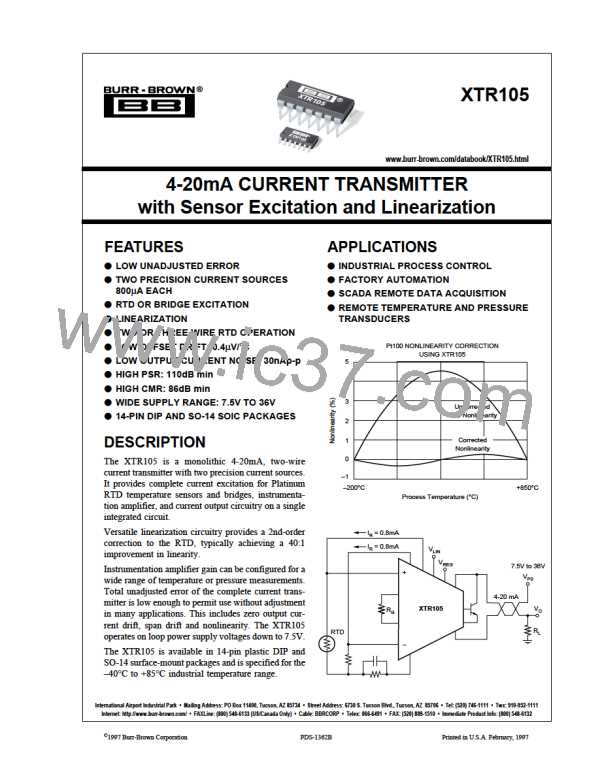REVERSE-VOLTAGE PROTECTION
Most surge protection zener diodes have a diode character-
istic in the forward direction that will conduct excessive
current, possibly damaging receiving-side circuitry if the
loop connections are reversed. If a surge protection diode is
used, a series diode or diode bridge should be used for
protection against reversed connections.
The XTR105’s low compliance rating (7.5V) permits the
use of various voltage protection methods without compro-
mising operating range. Figure 4 shows a diode bridge
circuit which allows normal operation even when the volt-
age connection lines are reversed. The bridge causes a two
diode drop (approximately 1.4V) loss in loop supply volt-
age. This results in a compliance voltage of approximately
9V—satisfactory for most applications. If 1.4V drop in loop
supply is too much, a diode can be inserted in series with the
loop supply voltage and the V+ pin. This protects against
reverse output connection lines with only a 0.7V loss in loop
supply voltage.
RADIO FREQUENCY INTERFERENCE
The long wire lengths of current loops invite radio frequency
interference. RF can be rectified by the sensitive input
circuitry of the XTR105 causing errors. This generally
appears as an unstable output current that varies with the
position of loop supply or input wiring.
If the RTD sensor is remotely located, the interference may
enter at the input terminals. For integrated transmitter as-
semblies with short connection to the sensor, the interfer-
ence more likely comes from the current loop connections.
SURGE PROTECTION
Remote connections to current transmitters can sometimes be
subjected to voltage surges. It is prudent to limit the maximum
surge voltage applied to the XTR105 to as low as practical.
Various zener diode and surge clamping diodes are specially
designed for this purpose. Select a clamp diode with as low a
voltage rating as possible for best protection. For example, a
36V protection diode will assure proper transmitter operation
at normal loop voltages, yet will provide an appropriate level
of protection against voltage surges. Characterization tests on
three production lots showed no damage to the XTR105
within loop supply voltages up to 65V.
Bypass capacitors on the input reduce or eliminate this input
interference. Connect these bypass capacitors to the IRET
terminal as shown in Figure 5. Although the dc voltage at the
IRET terminal is not equal to 0V (at the loop supply, VPS) this
circuit point can be considered the transmitter’s “ground.”
The 0.01µF capacitor connected between V+ and IO may
help minimize output interference.
NOTE: (1) Zener Diode 36V: 1N4753A or General
Semiconductor TransorbTM 1N6286A. Use lower
voltage zener diodes with loop power supply
voltages less than 30V for increased protection.
See “Over-Voltage Surge Protection.”
10
V+
0.01µF
1N4148
(1)
B
E
D1
XTR105
Diodes
9
8
Maximum VPS must be
less than minimum
voltage rating of zener
RL
VPS
diode.
IO
The diode bridge causes
a 1.4V loss in loop supply
voltage.
7
IRET
6
FIGURE 4. Reverse Voltage Operation and Over-Voltage Surge Protection.
®
12

 BB [ BURR-BROWN CORPORATION ]
BB [ BURR-BROWN CORPORATION ]